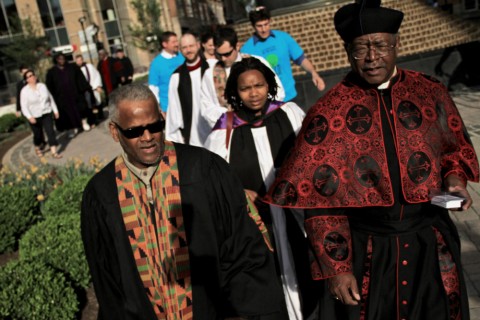Building Baltimore: A coalition connects police and community

On Wednesday, July 8, Baltimore Police Commissioner Anthony Batts joined a long list of police commissioners who’ve been fired by Baltimore mayors. For many Baltimoreans, the firing fit a familiar pattern: a rise in murders leads to community pressure for safety. The mayor, feeling the political heat increase with an election less than a year away, needs to show some action. Somebody has to be sacrificed. It may as well be another police commissioner.
Such was the cynical judgment also of many around the country when they heard that a reform-talking police chief had been ousted in Baltimore. But on the ground, the details painted a different story.
For at least a year prior to the death of Freddie Gray in police custody, residents in the neighborhood of Sandtown-Winchester had been calling for additional police in their neighborhood. They met with the acting commander of the Western District and logged details of police response times in their neighborhood, comparing them to response times in the middle-class neighborhood where the church I pastor is located, just a mile away. They discussed the need for foot patrols—officers who would walk the streets, learn the names of residents, and listen to those who were committed to doing their part to rebuild a neighborhood still struggling from the legacy of redlining, unemployment, and the war on drugs.
Read our latest issue or browse back issues.
In the neighborhood where I pastor, an uptick in crime immediately leads to increased police patrols. In Sandtown-Winchester, an uptick in crime led to little more than police commanders lecturing the community on why they didn’t have enough resources to add officers. Such were the issues over a year ago when residents in Sandtown-Winchester joined residents of Bolton Hill and several other neighborhoods in the No Boundaries Coalition to leverage their collective power and demand a change.
The change was slow in coming. In the week when foot patrols were finally added, Ray Kelly, president of the No Boundaries Coalition, a black man who lives in the Sandtown-Winchester neighborhood, approached a new officer, hand extended, to say welcome to our neighborhood and thank you for coming. The officer, arms crossed, replied, “I don’t shake hands.” It was yet another example of the broken relationship between minority residents of high-crime neighborhoods and police who enter their communities treating all residents as suspects to be subdued. Kelly was stopped and frisked three different times that same week for the crime of walking home.
Fortunately for Kelly and fellow neighbors, this wasn’t the only example in Baltimore of poor relationships between police and residents. On the east side, residents in the Oliver, Johnston Square, and Darley Park neighborhoods have been working for several years to deepen respect and trust between police and neighbors. BUILD, a 37-year-old organization of churches and school and community agencies (including the No Boundaries Coalition), scheduled regular, face-to-face meetings between police and residents. As trust began to deepen, police and community residents took greater risks in the relationship and public safety improved.
When BUILD’s 600-home redevelopment work in Oliver ran headlong into the drug activity and attending violence that threatened efforts to rebuild the community, the churches in the area listened to those selling drugs on the corners. “If I could find a legitimate job that paid as much as this,” more than one young man told them, “not only would I get off this corner, I’d help keep it clean.”
The churches responded by founding Turnaround Tuesday, BUILD’s weekly program to rebuild the spirits of ex-offenders, equip them for meaningful work, and with their leadership organize employment to transform their lives. Police in the neighborhood saw the wisdom of the effort. The crime problem is a jobs problem. More than 60 people have now been employed through Turnaround Tuesday. Rather than criminalizing young people for acting in their own self-interest, Turnaround Tuesday is developing economic competition to squeeze out the drug economy.
Back in Sandtown, two months after the protests that followed Gray’s death, leaders from these eastside neighborhoods joined those from Sandtown-Winchester, Bolton Hill, and other neighborhoods to fill the sanctuary at St. Peter Claver Catholic Church. We gathered to announce our plans to continue building “one Baltimore.” We heard from the people whose voices are so often lost in the news—people like William Glover-Bey, who shared what it felt like to have a real job after being shot three different times and serving more than 15 years in prison. We gathered with elected officials, but also with Ron Daniels, president of Johns Hopkins University, a $10 billion institution and Maryland’s largest private employer. Inspired by our work, Daniels committed to working with other employers in a strategy to bring hundreds of jobs to Baltimoreans, with a specific focus on citizens returning from prison, who so seldom get a second chance.
So when BUILD called for the resignation of Police Commissioner Anthony Batts early on the morning of July 8, it was not simply another example of a police commissioner being thrown under the bus. We had met twice with the commissioner since the Baltimore uprisings, calling for a plan to address the spike in violence that contributed to Baltimore’s deadliest month of murders in more than 40 years. He never delivered a plan. We saw the reality of a police commissioner who had lost the following of his rank and file in a city that was desperate for peace. We saw good police work in Baltimore going unnoticed and unrecognized when it could have become a new national model for effective policing.
We have met with the new police commissioner and liked what we heard. Kevin Davis is a native of neighboring Prince George’s County. He professes to understand the defining role that race plays in the city and the politics of his position—the greatest challenge any reform-minded commissioner faces. And he speaks knowledgeably of the kind of constitutional policing that is not only good for police-citizen relationships, but reduces crime too.
We’re already talking about face-to-face meetings with police commanders to begin rebuilding understanding and trust. Despite the very real divisions between police and citizens and the racial bias that continues to infect the Baltimore Police Department and police departments across the nation, there is always a good deal of understanding at the face-to-face, human level. When you find out, for example, that one of the heads of the police divisions is also the father of a son who served time in prison, you begin to see the possibilities for connection, the hope of a future that the church is invited to believe before it’s seen.
Of course, there’s always the possibility that hopes and dreams won’t pan out. There is a fine line between hope and a denial of the facts on the ground. But that’s nothing new for the church, and it’s nothing new for BUILD either. Every win in our organization’s history—the first living wage ordinance in the world, the largest after-school program in Baltimore, 1,000 Nehemiah homes, $1 billion for new school construction—came with a fight. But a diverse group of Baltimoreans surprised everyone by working together. Justice doesn’t happen when leaders make good promises. It happens when they are held accountable to them.
That’s what makes Christian hope so real—it’s rooted not in platitudes, but in a God whose marks we can see in our history. That God has tipped the scales toward justice more times than we can count in Baltimore. It’s why many of us embrace the vision to “BUILD One Baltimore” even as we live in a city divided. We’ve seen what God has done in the past so we have an inkling of where God is headed.





